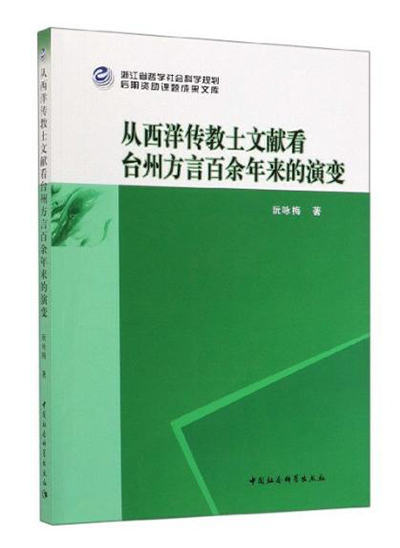A linguistic analysis of Taizhou dialect since the 19th century

The Evolution of Taizhou Dialect over the Past Hundred Years Based on Western Missionaries’ Literature
The Evolution of Taizhou Dialect over the Past Hundred Years Based on Western Missionaries’ Literature analyzes the phonetic system, major classified words, and grammatical features of Taizhou dialect in the 19th century, based on the Taizhou-dialect documents of 19th-century Western missionaries, particularly the historical contributions made by the group to the translation of the Taizhou-dialect Bible.
Written by Ruan Yongmei, a professor from the School of Humanities and Communication at Ningbo University, the book also makes synchronic and diachronic comparison with Mandarin and such Wu dialects as Ningbo dialect, Wenzhou dialect, and Shanghai dialect, exploring the historical changes of Taizhou dialect over more than a century.
Contemporary Western historical linguist E. F. K. Koerner put forward three principles for the research of linguistic historiography: formative background, textual evidence, and public acknowledgement. The formative background emphasizes placing the research object in an external context, and comprehensively considers the influence and restriction of social, economic, political, ideological, and cultural factors on the research object. Following the principle, the book exhibits the interdisciplinary characteristics of linguistics, religious studies, historiography, and other disciplines, increasing the humanity of linguistic research, widening the research depth and breadth, and facilitating comparative research with similar pertinent documents.
If the formative background refers to a grand context, then textual evidence stresses a small context. The interpretation of missionaries’ Chinese dialect texts requires researchers to have solid and comprehensive linguistic skills and humanistic literacy. In addition, “dead” documents must be interpreted and combined with “living” linguistic investigations, that is, sticking to the practical tradition of Chinese linguistics, so that documents can be confirmed diachronically and synchronically and pass on the research tradition of “combining materials and viewpoints.”
The principle of public acknowledgement highlights the researcher’s written expression of linguistic historiography, with the aim of effectively solving the problems regarding understanding, resurrecting, publicizing, and promoting historical literature, since such research involves multiple factors and relationships, such as Chinese and foreigners, intellectuals and illiterates, Chinese and foreign languages, and the official language and dialects.
An important way to public acknowledgement is to identify the classification and stratification of target readers. The classification of target audiences means different research fields divided by linguistics, religious studies, historiography, and other disciplines, while the stratification refers to the professional level of scholars and the popularization level of the general public.
Tao Huan is a professor from the Department of Chinese Language and Literature at Fudan University.
Edited by YANG LANLAN
